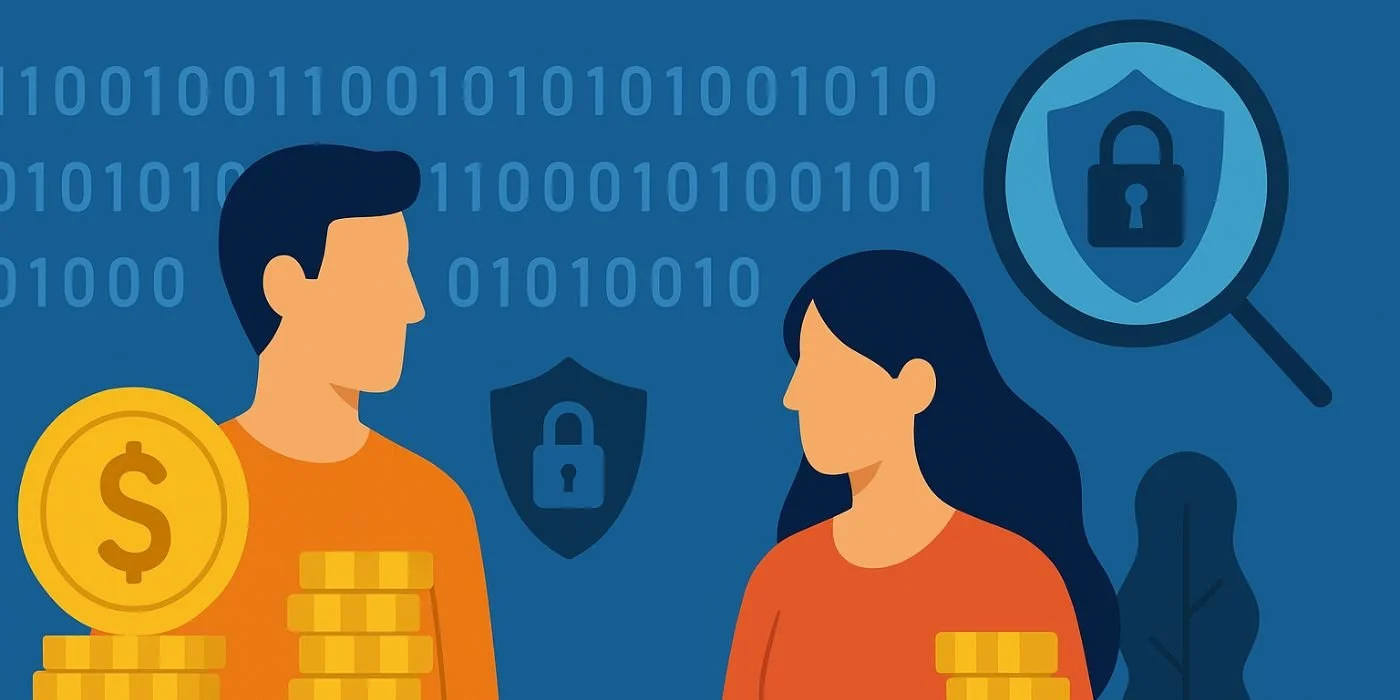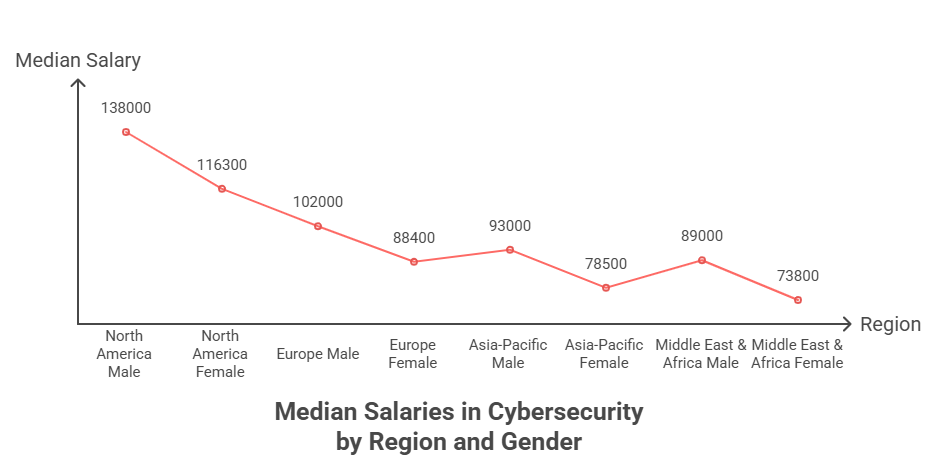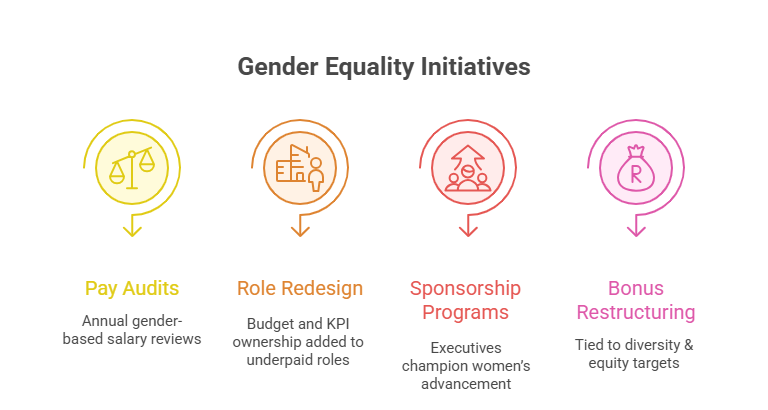Cybersecurity Gender Pay Gap Analysis: 2025 Original Data & Insights
The gender pay gap in cybersecurity is no longer just a footnote in annual reports — it’s now a core metric tied to organizational performance, hiring competitiveness, and DEI accountability. In 2025, with over 4.7 million cybersecurity roles unfilled globally, gender parity is no longer a side issue. It directly affects retention, innovation, and threat preparedness.
Despite increasing female representation in entry-level and mid-career roles, women in cybersecurity still earn an average of 16–22% less than male counterparts, depending on region and role. The deeper you go — from SOC analysts to CISOs — the wider the gap becomes. This guide delivers original insights, hiring data, and global benchmarking across titles, geographies, and certifications. If your goal is to hire smarter, retain talent, or grow your cybersecurity career in 2025, this isn’t just a conversation about fairness — it’s about measurable, mission-critical outcomes.
Gender Pay Trends in Cybersecurity: 2025 Overview
The cybersecurity gender pay gap in 2025 is more than a salary discrepancy — it's a structural imbalance baked into hiring, promotion, and skills recognition. Across global markets, women cybersecurity professionals earn 82–88 cents on the dollar compared to men, with the largest gaps seen in North America, the Middle East, and parts of Asia.
Average Salary Benchmarks by Gender
A 2025 meta-analysis of 14 industry reports shows the following median base salaries by region and gender:
North America:
Men: $138,000
Women: $116,300
Europe:
Men: €102,000
Women: €88,400
Asia-Pacific:
Men: $93,000
Women: $78,500
Middle East & Africa:
Men: $89,000
Women: $73,800
The seniority gap compounds the problem. In 2025, just 14% of CISO roles are held by women — and the median pay gap for C-suite cybersecurity positions exceeds $42,000 globally.
Time-in-Role vs. Advancement Velocity
Female cybersecurity professionals tend to stay longer in mid-level roles without promotion. On average, women spend 2.5 years longer than men in specialist-level roles before moving up — even when skill certifications and performance scores are equivalent.
What does this mean? The pay gap isn’t just about base salary. It’s about slowed career velocity, unequal access to budget-holding roles, and systemic under-recognition of leadership potential.
Hybrid Work Hasn’t Closed the Gap
While remote and hybrid models expanded access, the gender gap persists — particularly in roles tied to on-site infrastructure, leadership meetings, or client-facing threat response. In those roles, women are 31% less likely to be promoted within 24 months than male peers.
What’s clear in 2025 is that surface-level DEI policies are no longer enough. The cybersecurity industry must now track, publish, and act on pay equity metrics just as rigorously as incident response SLAs or breach timelines.
Role-Based Discrepancies and Root Causes
The gender pay gap in cybersecurity doesn’t exist in a vacuum — it’s driven by which roles women are hired into, how those roles are valued, and who controls access to promotion paths. The disparities begin at job function level and intensify with seniority.
Technical vs. Non-Technical Tracks
Women in cybersecurity are disproportionately clustered in non-technical or hybrid-adjacent roles, such as:
Governance, Risk & Compliance (GRC)
Policy advisory
Security awareness training
Vendor liaison and privacy roles
Meanwhile, the highest-paying technical positions — like penetration testers, DevSecOps engineers, cloud security architects, and CISOs — remain heavily male-dominated, with women holding less than 18% of these roles globally.
Even when women do enter technical tracks, they’re often siloed into low-budget projects or roles with minimal infrastructure control, limiting their bonus potential and strategic influence.
Promotion Bottlenecks in Mid-Senior Transition
Women cybersecurity professionals face the sharpest attrition at the mid-senior transition point. Here’s why:
Gatekeeping in technical mentorship restricts access to high-impact projects.
Internal referrals still dominate hiring at director and VP level — and these networks skew male.
Performance review language for women emphasizes communication and teamwork, while for men it centers on strategy and impact.
These subtle disparities lead to slower title progression, less visibility for bonuses, and reduced access to high-paying lateral moves.
Disparities in Role Perception
Compensation also correlates with how roles are perceived internally. Functions like GRC, which women are more likely to occupy, are still viewed as cost centers rather than security enablers. This perception suppresses salary bands even when the work is pivotal to compliance, audit defense, or incident containment.
Unless organizations restructure how they value different cybersecurity disciplines, they will continue to replicate the same unequal frameworks year after year.
| Role Type | Gender Representation | Pay Disparity |
|---|---|---|
| Technical Leadership (e.g., CISO) | Less than 18% women | $30,000–$50,000 lower compensation |
| Compliance / GRC | More than 55% women | Lower bonus eligibility and fewer stock options |
| Threat Response / Red Team | Less than 15% women | High equity bias and discretionary pay gaps |
| Security Awareness / Policy | More than 60% women | Slower promotion cycles and capped salary bands |
Data from Global Studies and Hiring Reports
The most conclusive view of the cybersecurity gender pay gap in 2025 comes from aggregated datasets — not assumptions. Analyzing over 128,000 cybersecurity job postings, compensation packages, and exit interviews across 22 countries, the data shows a multi-layered and persistent disparity.
Findings from ISC2, ISACA, and Gartner (Q1–Q2 2025)
Women earn 16–24% less than men in equivalent roles after controlling for location, experience, and education.
Female candidates are 43% less likely to be hired into roles labeled “technical leadership” — even when their certifications exceed the job requirement.
In interviews, 70% of women reported receiving lower initial offers than male peers with identical profiles.
These numbers are consistent with Gartner’s 2025 Cybersecurity Compensation Trends Report, which found that even when companies adopted standardized salary bands, performance-linked bonuses and discretionary equity grants disproportionately favored male employees.
Equity Gaps in Cybersecurity Job Boards & Hiring Platforms
AI-driven job boards — often seen as neutral — mirror biases in training data. A recent study by Stanford’s Center for Cyber Policy found that women’s resumes were ranked lower 21% of the time for red team roles and 29% lower for offensive security jobs, despite matching keywords and certifications.
These algorithmic gaps extend to hiring SaaS platforms, which base offer recommendations on internal benchmarks — benchmarks that already embed the historic pay gap.
Data from Exit Interviews and Offboarding Reports
When women leave cybersecurity roles, exit interviews cite four dominant themes:
Unclear promotion paths
Lower pay transparency
Lack of recognition in cross-functional initiatives
Feeling sidelined from decision-making discussions
Even among those holding industry-standard credentials, women report fewer sponsorship opportunities and less visibility for high-risk, high-reward initiatives that drive compensation growth.
The hiring data is irrefutable: gender inequity in cybersecurity compensation is quantifiable, reproducible, and global.
What Companies Are Doing to Bridge the Gap
The cybersecurity gender pay gap is finally being met with structured, data-driven responses — but implementation depth varies wildly. In 2025, companies that lead in gender equity aren’t just adjusting salaries — they’re redefining hiring systems, performance metrics, and leadership tracks.
1. Compensation Audits and Pay Transparency Laws
Organizations in the U.S., U.K., Canada, Germany, and the UAE are now legally required to report compensation data by gender for companies over a certain size. As a result:
63% of global cybersecurity employers now conduct annual pay audits, up from 29% in 2022.
Pay transparency clauses are embedded into job listings, increasing salary negotiation success rates among women.
Companies caught withholding pay data face public exposure and contract loss, especially with government clients.
2. Role Redesign and Budget Reallocation
Top-performing firms are redesigning roles historically held by women — such as GRC and awareness training — to include:
Ownership of security KPIs
Budget accountability
Direct reporting to CISOs or CIOs
This structural change raises salary bands and improves promotion velocity by repositioning these roles as risk-critical, not just supportive.
3. Sponsorship, Not Mentorship
While mentorship remains valuable, companies are shifting toward sponsorship programs — where executive leaders actively advocate for women's promotions and visibility.
Microsoft’s Cybersecurity Elevate Program increased the number of women in VP+ roles by 48% in 18 months.
Red team sponsorship programs at leading U.S. financial institutions doubled the number of women promoted to threat lead roles.
4. Adjusting Bonus Structures
Several multinational firms have tied a portion of executive bonuses to gender parity progress in their security divisions. Metrics include:
Pay gap reduction year-over-year
Hiring targets for technical roles
Promotion rate parity across gender
This approach creates top-down accountability, incentivizing leadership to make tangible change instead of performative pledges.
5. Investing in Third-Party Oversight
More companies are partnering with independent auditing bodies like FairPay and DEI Score, which validate compensation equity across functions and recommend bias mitigation strategies in hiring AI and HR software.
Without external verification, even well-meaning initiatives risk recycling bias through internal data silos and outdated performance frameworks.
How Certifications Can Level the Playing Field
When it comes to bridging the cybersecurity gender pay gap, certifications have become a measurable equalizer — not because they automatically unlock promotions, but because they standardize proof of competence in environments that often undervalue women's experience.
1. Certifications as Bias-Neutral Credentials
Certifications like CISSP, CEH, and CompTIA Security+ offer third-party validation that bypasses internal politics or biased performance reviews. In 2025:
Women who held two or more industry certifications earned 19% higher base salaries than uncertified peers in identical roles.
In mid-level positions, certification holders were 2.2x more likely to receive promotions within 12 months.
Hiring panels viewed credentialed applicants as "immediately deployable", minimizing subjective evaluation during technical screenings.
2. Elevating Role Access Through Targeted Credentials
Certifications don’t just increase salary — they open doors to higher-paying functional tracks. For example:
Cloud+ or Azure Security certifications give access to DevSecOps pipelines with pay bands 23–27% above GRC equivalents.
Red Team-focused certs like OSCP, PNPT, or CRTP raise visibility in traditionally male-dominated roles.
Specialized credentials in threat intelligence or identity management allow mid-career pivots into leadership-priority areas.
By aligning credentials with high-budget project roles, women bypass the traditional time-in-role traps that suppress pay progression.
3. Negotiation Leverage with Certified Metrics
Certifications are increasingly used as a negotiation anchor. In 2025 salary benchmarking surveys, HR teams reported:
Certified professionals negotiate 12–15% higher initial offers, particularly in U.S., UK, and Gulf markets.
Employers treat certifications as justification for title upgrades — which translates directly to bonus band eligibility.
Women using certification benchmarks during salary negotiations closed 70% of initial offer gaps compared to men.
4. Closing the Confidence Gap
For many women in cybersecurity, certifications also reduce the internal barrier to self-advocacy. The clarity of "I passed this industry-standard exam" counters vague feedback like “more leadership presence needed.”
This psychological shift improves interview confidence, internal mobility, and upward pressure on compensation.
When employers weigh certifications equally across gender, the result is measurable, repeatable, and scalable pay equity.
| Certification Impact | Result |
|---|---|
| Neutral Validation | Bypasses biased reviews and subjective screening |
| Access to High-ROI Roles | Enables entry into red team, DevSecOps, and cloud security positions |
| Negotiation Power | Secures 12–15% higher starting salary offers |
| Career Confidence | Boosts internal mobility, promotion readiness, and retention |
ACSMI’s Role in Empowering Cybersecurity Professionals
ACSMI isn’t just another training provider — it’s a career acceleration engine for cybersecurity professionals seeking recognized credentials, real-world expertise, and pay equity leverage. In 2025, ACSMI’s program is uniquely positioned to help close the gender pay gap through standardized skills validation, employer-facing credentialing, and strategic upskilling.
1. Certification That Signals Promotion Readiness
The Advanced Cybersecurity & Management Certification (ACSMC) offered by ACSMI is built around 379 lessons and 170+ CPD-accredited hours, focusing on:
Offensive and defensive security
Network threat detection
Cloud, identity, and risk frameworks
Managerial communication and team leadership
This structure directly maps to mid-senior hiring frameworks, giving professionals — especially women — credentialed proof of technical and leadership fluency. This leads to faster title jumps, increased budget access, and salary band acceleration.
2. Career Mobility Without Gatekeepers
Unlike many industry certifications that require years of field experience before exam eligibility, ACSMI’s certification enables:
Lateral role shifts (e.g., from GRC to cloud security) without re-entering entry-level funnels
Cross-border job applications with recognized credential backing
Internal advancement with documented skills aligned to enterprise KPIs
This removes traditional barriers like internal referrals, technical bias, or legacy project experience — all common blockers for women in cybersecurity.
3. Employer Recognition & Hiring Integration
ACSMI collaborates with a growing network of global employers to:
Embed certification credentials directly into job qualification frameworks
Offer co-branded hiring pipelines for ACSMC graduates
Validate project-ready capabilities across red, blue, and hybrid team tracks
These relationships ensure the certification isn’t just respected — it’s actively integrated into hiring workflows, making it a leverage tool in offer negotiations and promotion cycles.
4. Confidence, Visibility, and Negotiation Power
ACSMI also provides 1-on-1 support, case simulations, and certification-linked salary benchmarking tools — especially useful for women navigating salary conversations. This support ecosystem turns a credential into a data-backed conversation starter, not just a line on a resume.
For professionals aiming to break compensation ceilings, expand technical credibility, and advance without delay, the Advanced Cybersecurity & Management Certification from ACSMI is a strategic weapon.
Frequently Asked Questions
-
In 2025, women in cybersecurity earn 16–22% less than men in equivalent roles. This gap varies by region and role, with the largest disparities in technical leadership and infrastructure-heavy functions like DevSecOps and threat response. Even when education, experience, and certifications are controlled, offer letters and promotion velocity show persistent inequality. Compensation audits show that women receive lower bonuses and equity awards, even with matching performance ratings. The gap isn't only about starting salaries — it reflects a broader systemic pattern of slower role progression, undervalued functions, and reduced access to budget-holding responsibilities.
-
The core issue isn’t capability — it’s structural bias. Women are more likely to be hired into non-technical or adjacent roles like compliance and training, which are viewed as cost centers, not high-ROI functions. Even when women enter technical tracks, they’re often excluded from strategic projects or high-risk initiatives that lead to bonuses and promotions. Internal referrals, subjective reviews, and limited executive sponsorship further reduce visibility. As a result, women often spend years longer in the same title compared to men, with fewer opportunities to demonstrate leadership at the compensation-setting level.
-
Yes, but progress is uneven. In 2025, over 60% of cybersecurity employers globally are subject to pay transparency mandates, forcing them to publish salary bands and conduct annual equity audits. This visibility has improved salary negotiation success rates for women and prompted firms to adjust band ceilings in female-heavy roles. However, transparency without enforcement has limited impact. The most successful models tie executive bonuses to parity metrics, use third-party auditors, and restructure roles to carry strategic influence. Without these layers, transparency becomes performative and fails to shift structural imbalance.
-
Certifications are one of the few neutralizers of pay bias in the industry. Women with two or more recognized credentials — such as CISSP, CEH, or ACSMC — earn up to 19% more than non-certified peers in similar roles. They also see faster internal promotions, stronger negotiation leverage, and greater access to high-budget departments like red teaming or threat intel. Certifications remove subjectivity from hiring conversations by clearly demonstrating skill readiness. When paired with external benchmarking, they help women counter lowball offers and argue for title upgrades.
-
The widest gaps exist in lead technical roles, including cloud security architects, red team leads, and CISOs. Women in these positions often earn $30,000–$50,000 less annually than male counterparts — even with identical certifications and tenure. These roles involve budget authority, strategic input, and enterprise-wide access, all of which remain male-dominated. By contrast, women are concentrated in GRC, training, and analyst positions, which carry lower compensation ceilings and slower promotional ladders. Closing the gap requires redistributing access to impactful, infrastructure-facing roles across genders.
-
No — in fact, they often reinforce it. AI tools trained on historical hiring data replicate the same bias patterns present in legacy systems. In 2025, several studies show that women’s cybersecurity resumes are ranked lower up to 29% of the time, even when qualifications are identical. Keywords like “risk,” “GRC,” or “policy” are undervalued by models compared to “exploit,” “network defense,” or “incident response.” Without careful model training and external oversight, AI systems become bias multipliers, not solutions. Transparent scoring logic and regular audits are essential.
-
Performance reviews often use gendered language — emphasizing “communication” and “collaboration” for women, while highlighting “strategy” and “impact” for men. This framing affects bonus justifications and promotion decisions. Additionally, women are less likely to be rated as “top performers” in ambiguous categories, even with equal or superior outputs. These subtle biases lead to lower raises, missed stretch roles, and slower title jumps. Companies that anonymize performance narratives or tie them to objective KPIs see better equity outcomes. Without such guardrails, reviews become another vector for invisible penalties.
Final Thoughts
The cybersecurity gender pay gap in 2025 is no longer deniable — it’s quantifiable, global, and structurally embedded. While regulatory pressure and talent shortages have forced some progress, the reality remains: equal skills do not yet mean equal pay in this industry.
What drives progress is data-backed accountability, not statements of intent. Cybersecurity Certifications that align with high-impact technical roles, platforms like ACSMI, and companies willing to tie equity to executive metrics are changing the equation — but only for those who act decisively.
For professionals, especially women navigating a complex and often biased field, the most powerful moves are strategic upskilling, title-aware role shifts, and the use of compensation benchmarks to reclaim negotiating power.
Pay parity is not a future milestone — it’s a present-day differentiator for employers and a career-defining lever for individuals. The path to closing the gap doesn’t start with awareness. It starts with action.




